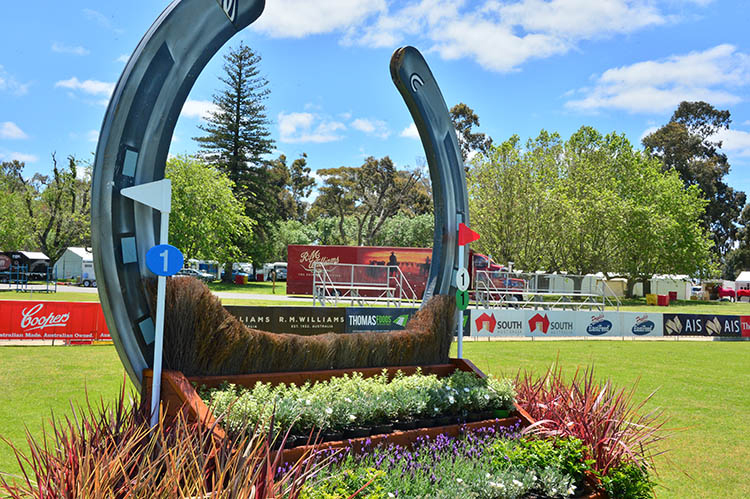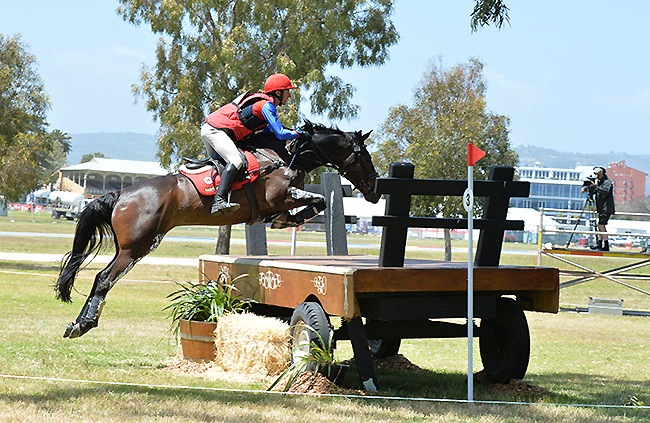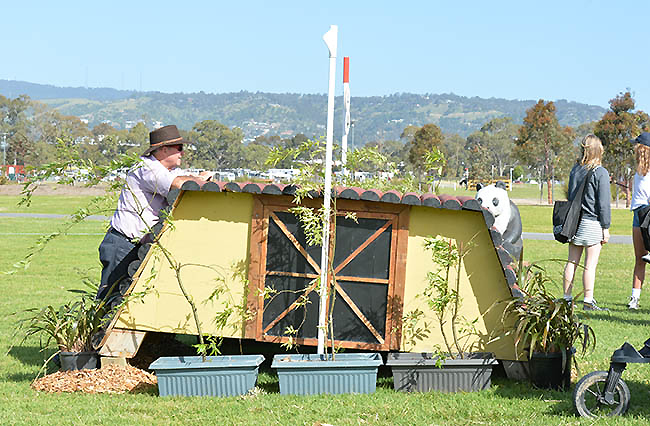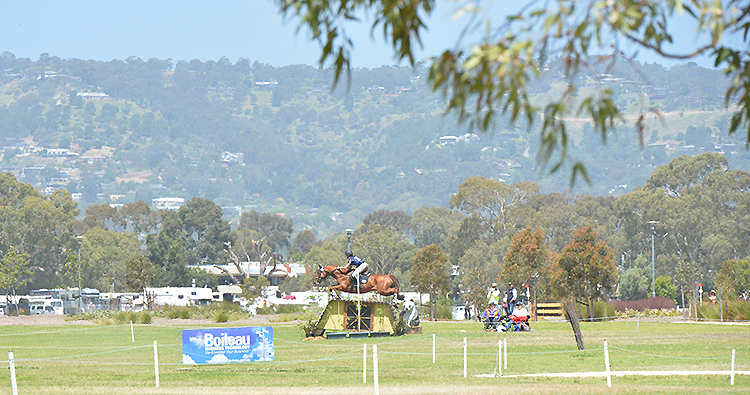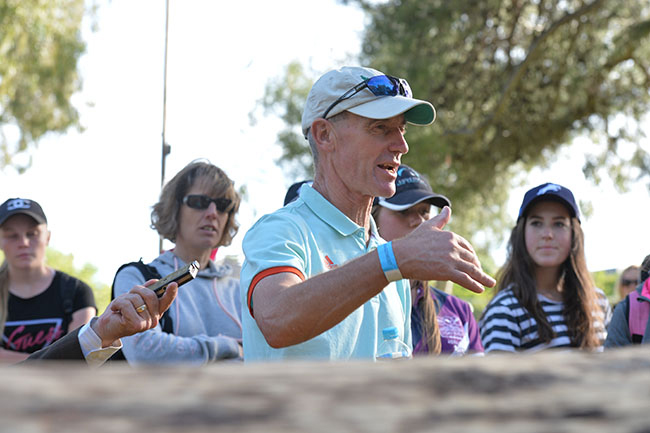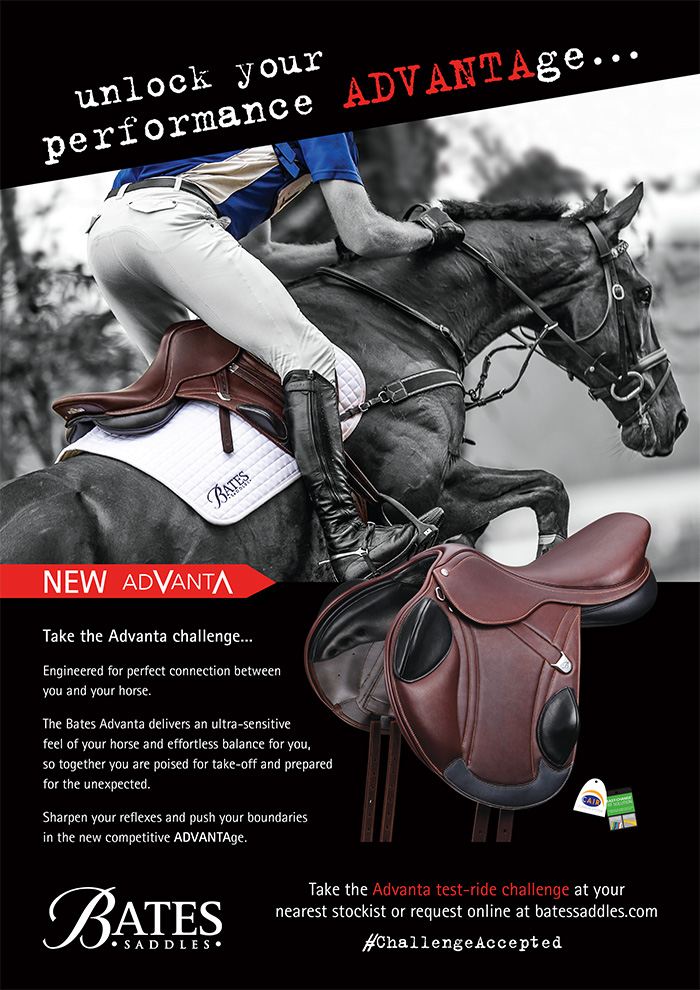Riding a cross-country course – Step 1 Starting out on course: Christopher Bartle, Badminton winner, and trainer of Multi Medal winning teams, looks at a few of the Adelaide four-star cross country fences, and more importantly, explains how they should be ridden…
“Fence 1 is quite a simple fence, but we want to see our preparation point, and bear in mind every stride is half a second. With that in mind, we’ve come out of the start box, we have a nice rhythm to this fence.”
“Some riders ride backwards to the first fence – if you ride backwards to the first fence, you are going to be riding backwards all the way.”
“Here we are at fence two, we won’t dwell on it, but it is an opportunity to set out my rules – the rules are rhythm, balance, and in terms of riding the line, I have a rule that you make the turn before the fence, so always use the turn as a preparation point – preparation point for tempo, in other words, speed, balance, degree of collection you need. This is a rhythm fence, in other words, you can keep coming in quite a high tempo, but keeping the horse balanced, and look over the fence, not down into the bottom. Two pairs of eyes, the rider’s got a pair of eyes, the horse has got a pair of eyes, each do their own job, and be aware of the distance the horse is seeing.”
“Quick away from the fence and you get into your racing tempo again, you’ve got to find a rhythm that is comfortable for your horse, and bear in mind, you’ve got a long way to go.”
“Here we are at the third fence, we are still in that first phase of the course, where the course designer is looking for us to get into gear and settle into a rhythm before the technical questions come. I’d have a bit of respect for this, even though there is a straw bale underneath and a shrub in front of it – you don’t want to be making contact with the front. It’s not hugely wide, so you are coming in, as I said before, make the turn before the fence.
Rohan Luxmore shows how to do it on Bells & Whistles
I have a rule that you want to meet each fence on the inside of the midline, so I am coming off a left hand turn, I would tend to jump it slightly left of centre, this helps because it gives you a bit of a ground line here, look ahead to where you are going to go next, towards that tree, and then you don’t get too hooky to the base.”
“Hands down, eye up, and stay a little bit away with your upper body, to let the horse use its shoulder.”
What we have here is an A / B situation, very slight curving line from 4a to 4b.
Fence 4 A from the side, very different from front-on
What’s interesting when you see this fence from the side, is that there is a slight drop on landing, a fairly wide box. What’s so important in all these combination questions, is the security of your landing position, because that becomes the first stride in the approach to the next question. Turn before the fence, come up there at relatively high speed, you know you’ve got to land and curve, so you don’t want to be flying over this, then not be able to balance them in the turn. So you take a little bit of tempo out in the turn, not going out too wide, because that is a waste of time, but controlling them on the outside rein while you look for the line over A. Once you’ve nailed the line to A, then even before taking off at A, you will be looking to B, and what’s important there, is that as you land over A, weight in your stirrups, eye up on B, and not have that ‘nod’ on landing which one sometimes sees in cross country riding, where for that moment, the rider has lost their line.
“The point that I make to riders time and time again, is that the horses have never walked the course, so they have to assess things in a mille-second, whizzing past tree left, and tree right, then suddenly you have tree stumps you have to jump and not whiz past.”
“On the positive side, because horses are such intelligent, quick thinking characters, they help us out an awful lot if we give them a chance to do that. If you can guide them correctly, and not dictate to them, that is the essence of fantastic cross country riding. You’ve walked the course yourself, you know what is coming, therefore you have them in the right tempo and the right balance and the right gear for the question, then show them the question and allow them to do their job.”
Hazel Shannon and Clifford are on the job…
“Once you guide him and have his focus on the next fence, he should do his very best, but it is up to us to have the line right, the balance right, and let the horse focus on his job. It means letting the rein a fraction longer before the take off, because if you jump this like a showjumper with your hands half way up the neck, leaning forward, then you could lose your first stride on landing.”
“We could all measure this, I did yesterday, and it is probably three strides, but I tend not to talk about strides, because every horse is different, you can have a giant and you can have a pony. What’s most important is that you focus on the balance and the line, allow your horse to use his eye, and use your eye to see what distance the horse has seen.”
“We are coming in off quite a long gallop to what they call a stick pile, quite big sticks!”
“The line is very slightly bending, and it can be ridden at a relatively high tempo, which you will have coming off a quite open gallop. The important thing with a big wide fence like this, is not to take the first stride you see and take off too soon. Keep the rhythm, soften the hands, come a little bit deeper to it, let horse come a little deeper by being softer with the hand.”
“The most important thing about the stick pile, is that the next question, 6 A / B is two angled brushes, so in jumping this, we’ve got to be going out to the turning point to achieve that line from A to B.”
“You’ve got the red flag of B, the white flag of A, that creates a tunnel with the tree in the background. That’s my line of approach.”
“Come over the stick pile, straight towards A, we would then have to pull right and then left – and that’s confusing to the horse. It’s always helpful to line something up, like a tree in the distance, a point behind the fence that is your target as you come through the turn, then you know you’ve got your line to the angled brushes.”
“So we’ve come over the stick pile at relatively high tempo, but then we have to get that preparation point in the turn, without losing too much impulsion and tempo, because we want a positive approach to 6 A / B, at the same time we have to make sure the horse is seeing the line. When you have these angled fences, my rule is always to keep the degree of angle, as little as possible. I could take a one metre step to the left and make it tighter and that could be even better, I’ve still got that big tree in the distance as my line, but by doing that you make the question clearer for the horse, you are not angling each fence quite as much.”
“As soon as you have these angled fences, some people will walk the distance and calculate how much it is. I always want the distance to be on the short side, so that when I jump into the second stride, my body is coming up, rather than hunting for a second stride. So keep the distance on the short side. If you are looking from here, you’ve got the red flag of B, the white flat of A, that creates a tunnel with the tree in the background. That’s my line of approach. They’ve got a nice shape to them, a nice round shape in front, so I am not too worried about the front profile, I’m always going to look at B, not at A, and if I keep my eye focused on B, then I should hold my line.”
“The critical fence at Rio, the angled brushes, where I would say a lot of the problems happened because the riders were not looking at B, they were looking at A. Don’t look at A, look at B.”
for more of the course:
Eventing Exclusive – The Way Forward with Christopher Bartle (2)

